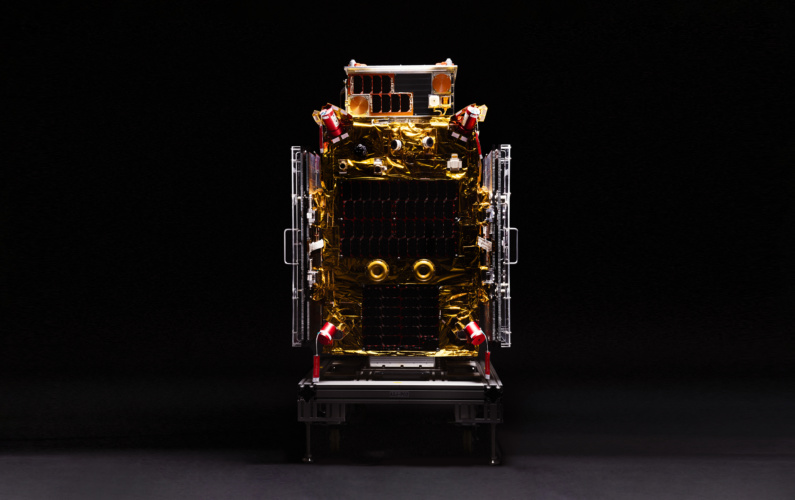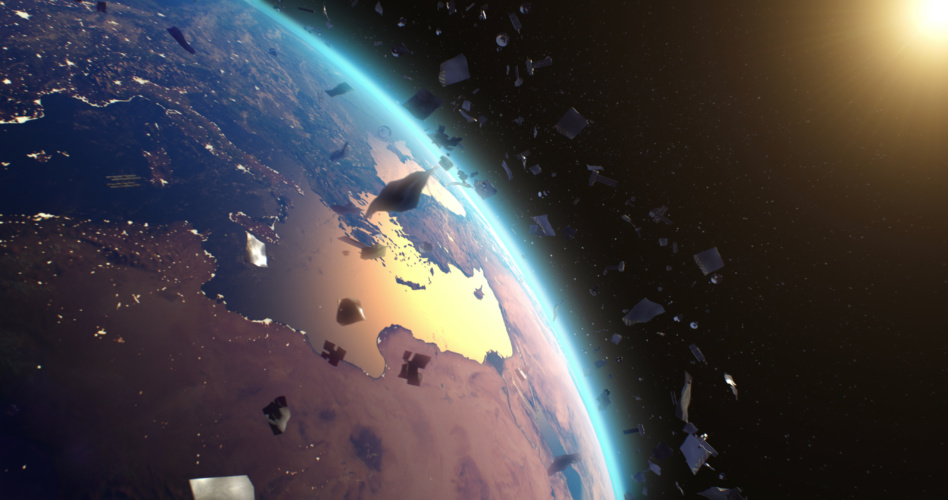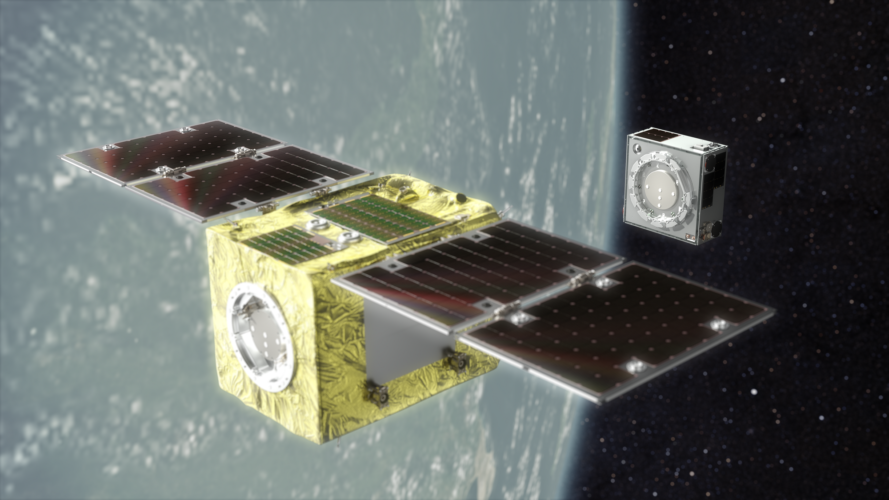Satellite technology has come a long way since the Soviet Union launched Sputnik 1 in 1957, its simple, hypnotic radio signal belying the monumental changes it would herald. In the intervening years, Earth’s inhabitants have come to rely on satellites for everything from TV broadcasting and GPS to weather forecasting and monitoring climate change.

Naturally, this dependence has led to proliferation, and the skies above have become ever more densely packed with chunks of metal orbiting the planet at enormous speeds. Sometimes, they collide. One of the biggest orbital impacts to date took place in 2009 when the defunct Russian satellite Kosmos-2251 collided with Iridium 33. The relative speed of impact was estimated at 11.7 km/s or about 42,120 km/h, two large objects violently transformed into thousands of small ones in an instant. For the space industry, it’s the stuff of nightmares.
“Some people say we’ve already triggered what’s called the Kessler syndrome, where a NASA scientist predicted that, as debris collided, this would increase more and more…and the collisions become more frequent,” said John Auburn, the UK managing director and chief commercial officer of satellite removal company Astroscale.
This feedback loop, where space debris sets off an irreversible cascade of orbital collisions, is a very real possibility and may – as Auburn alludes to - already be in its primordial stages. Not only could it lead to low Earth orbit (LEO) becoming a wasteland of hurtling junk where satellites can no longer operate, it could also make space travel exponentially more dangerous, theoretically trapping us on Earth in a spherical, atomised cage of our own failed technology.
COSMIC CLEAN UP: ADDRESSING THE SPACE DEBRIS PROBLEM
With stakes this high, it’s no surprise that the space community has been searching for solutions, albeit largely in the realm of the hypothetical until now. Nets, lasers, and harpoons have all been put forward as ideas to capture or destroy space debris, though actual testing in orbit has been limited in both scope and success. Astroscale is one of several private companies looking to change that.
It could also make space travel exponentially more dangerous, theoretically trapping us on Earth in a spherical, atomised cage of our own failed technology
Headquartered in Japan but with offices in the UK and elsewhere around the world, Astroscale launched its ELSA-d (End-of-Life Services by Astroscale demonstration) mission from Baikonur Cosmodrome in Kazakhstan in March 2021. Over the coming months the spacecraft will seek to showcase the key phases of an Active Debris Removal mission, performing complex rendezvous operations to demonstrate the capture of a target satellite using magnetic docking plates.
“What we have is a servicer and a client that are actually docked together when we launch,” explained Dr Jason Forshaw, head of Future Business (Europe) at Astroscale. “The servicer is the satellite doing the rendezvous, the complicated manoeuvres. It’s approximately 3.5m wide with the deployed solar panels and about 175kg. The client (17kg) is the one being captured, and this of course is simulating space debris.”
The first manoeuvre ELSA-d will perform will be a non-tumbling docking demonstration, where client and server will separate, then rendezvous and dock in a straight line in what should be a relatively straightforward procedure. The next phase will see both satellites separate once again, with the servicer then performing a fly around check-out demonstration to analyse the client and formulate the best approach to docking. As the target will be tumbling, this is a much more complex operation, one with which ELSA-d is equipped with cameras, laser rangers and radars to perform.

A third – even more complex - demo, known as client discovery, involves the servicer intentionally losing the client, then flying a ‘walking safety ellipse’ in order to rediscover and then recapture it. Assuming everything goes to plan, the servicer and client will then de-orbit, burning up in Earth’s atmosphere and accounting for the first couple of drops in the ocean of space debris above us. Mission control will be run from the new In-Orbit Servicing Control Centre (IOCC, pictured below right) at the Satellite Applications Catapult in Oxfordshire’s Harwell Campus.
“It will be the first mission to be controlled from this centre, and this IOCC is going to be the world’s first mission control centre dedicated to in-orbit servicing missions,” said Forshaw.
Astroscale’s hope is that its docking plate technology, or an alternative globally accepted standard, can be adopted by the entire space industry and rolled out across all new satellites and spacecraft. While this is an important step and can help futureproof the estimated 10,000 satellites expected to launch over the course of the next decade, it does little to address the problem of existing space debris.
“For Astroscale’s mission we need to do two things,” said Chris Walker, principal spacecraft operations engineer at Astroscale UK. “Keep the amount of debris that we’re adding to space to a minimum, and secondly, if we can, we want to bring down some of the big pieces of debris that are already up there.”
Since Sputnik’s launch, NASA and others have used a variety of methods to detect and track manmade objects in space, from satellites and spacecraft to larger pieces of debris. According to the United States Space Surveillance Network, there are approximately 20,000 such objects currently being tracked, as well as around 34,000 pieces of debris larger than 10cm that are not actively monitored, and an estimated 128 million pieces under 1cm.
On average, the ISS has to make about one manoeuvre a year to reduce the odds of an orbital impact with tracked objects. For smaller pieces, it’s equipped with Whipple Shields to disperse the huge quantities of energy carried by even tiny fragments at such high speeds. But anything above 1cm could potentially penetrate these shields, and this constant threat is something the station’s crew are all too aware of. Reducing that threat is essential for the future of crewed spaceflight.

“The scientists believe if we bring down five large objects a year, that will stabilise the situation,” said Auburn. “The threat is the smaller objects, but it’s the large objects that create that small debris.”
To this end, Astroscale is working with JAXA (Japan Aerospace Exploration Agency) with a view to launching a mission next year that will investigate the potential to remove an existing upper stage from a previously launched rocket.
“It will do inspection, it will work out how the rocket body is tumbling. Is it secure? Has it broken up?” Auburn said. “This is not prepared with any docking plate, obviously, and we’ll be bidding this year to go and actually bring that down.
“That will require some kind of robotic arm that you lock on, and we are developing that in Japan with other companies. And that could be a capability we could bring to the UK.”
Astroscale is also working on ELSA-M (the M stands for multi-client), the successor to the recently launched demonstrator, which will be capable of de-orbiting three or four large pieces of debris per mission. If successful, just a few ELSA-M missions per year could help keep the debris problem from escalating, and over time gradually make space a safer place for both astronauts and satellites. For the space industry, it’s existential, in every sense of the word.




Nanogenerator consumes CO2 to generate electricity
Whoopee, they've solved how to keep a light on but not a lot else.